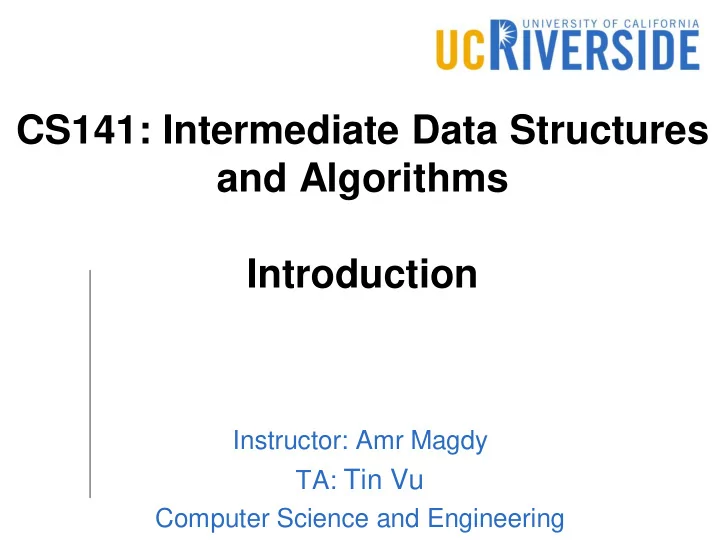

CS141: Intermediate Data Structures and Algorithms Introduction Instructor: Amr Magdy TA: Tin Vu Computer Science and Engineering
Welcome to CS 141 Instructor : Amr Magdy Office: Tomas Rivera Library, 159B http://www.cs.ucr.edu/~amr/ Email: amr@cs.ucr.edu ( Include [CS141] in the subject ) Office hours: MW: 3:30 - 4:30 PM TA : Tin Vu Office: Chung Hall, room 110 http://www.cs.ucr.edu/~tvu032/ Email: tin.vu@email.ucr.edu ( Include [CS141] in the subject ) Office hours: Thursday: 1:00 – 3:00 PM Course Website: http://www.cs.ucr.edu/~tvu032/18WCS141/ 2
Introduction to Computational Algorithms 3
Computer Programs Algorithms + Data Structures = Programs By Niklaus Wirth, Turing award winner 1984 4
What is Algorithm? According to Merriam-Webster dictionary a procedure for solving a mathematical problem (as of finding the greatest common divisor) in a finite number of steps that frequently involves repetition of an operation; broadly : a step-by-step procedure for solving a problem or accomplishing some end especially by a computer. 5
What is Algorithm? According to Merriam-Webster dictionary a procedure for solving a mathematical problem (as of finding the greatest common divisor) in a finite number of steps that frequently involves repetition of an operation; broadly : a step-by-step procedure for solving a problem or accomplishing some end especially by a computer. The word originates from “Algorism”: a mathematical counting technique
What is Algorithm? According to Merriam-Webster dictionary a procedure for solving a mathematical problem (as of finding the greatest common divisor) in a finite number of steps that frequently involves repetition of an operation; broadly : a step-by-step procedure for solving a problem or accomplishing some end especially by a computer. The word originates from “Algorism”: a mathematical counting technique Stemmed from the name of “Muhammad ibn Musa al- Khwarizmi”, an influencer mathematician
What is Algorithm? According to Merriam-Webster dictionary a procedure for solving a mathematical problem (as of finding the greatest common divisor) in a finite number of steps that frequently involves repetition of an operation; broadly : a step-by-step procedure for solving a problem or accomplishing some end especially by a computer. The word originates from “Algorism”: a mathematical counting technique Stemmed from the name of “Muhammad ibn Musa al- Khwarizmi”, an influencer mathematician “ Al-khorezmi his background, his personality his work and his influence ” by Heinz Zemanek, Springer LNCS, 1979, Algorithms in Modern Mathematics and Computer Science, pp 1-81 (https://link.springer.com/chapter/10.1007/3-540-11157-3_25)
Algorithms in Action 9
Algorithms in Action 10
Algorithms in Action 11
Algorithms in Action 12
Algorithms in Action 13
Algorithms in Action 14
Scope of Computational Algorithms Computability Complexity 15
Scope of Computational Algorithms Decide on problem computability: What problems can be solved by a computer? Computability Can a computer solve any problem, given enough time and storage space? Complexity 16
A computationally infeasible problem input n assume n>1 while (n != 1) { if (n is even) n = n/2 else n = 3*n+1 } 17
A computationally infeasible problem input n assume n>1 while (n != 1) { if (n is even) n = n/2 else n = 3*n+1 } Is this problem terminates for all possible n>1? 18
A computationally infeasible problem input n assume n>1 while (n != 1) { if (n is even) n = n/2 else n = 3*n+1 } Is this problem terminates for all possible n>1? We cannot write a computational algorithm to answer this question 19
Scope of Computational Algorithms Decide on problem computability: What problems can be solved by a computer? Computability Can a computer solve any problem, given enough time and storage space? Analyze a computational algorithm performance: How fast can we solve a problem Complexity using a computer? How little storage space can we use to solve a problem? Design better algorithms. 20
Scope of Computational Algorithms Decide on problem computability: What problems can be solved by a computer? Computability Can a computer solve any problem, given enough time and storage space? Analyze a computational algorithm performance: How fast can we solve a problem Complexity using a computer? How little storage space can we use to solve a problem? Design better algorithms. 21
Correct Algorithm A correct algorithm has two conditions: Halts/terminates Produces a correct output set for all possible input sets Will detail later on analyzing correctness of algorithms. 22
Grading and Policies Course work Five homework assignments (33%) Two quizzes (33%) Final inclusive exam (34%) Delivery policies: Late submission allowed for 20% penalty for a calendar day. Assignments should be computer-typed. Cheating is not allowed and will be reported If you are using any external source, you must cite it and clarify what exactly got out of it. You are expected to understand any source you use and solve problems in your own. 23
Reference Book Introduction to Algorithms, 3 rd Edition, 2009, Thomas Cormen et. al. 24
Course Content Introduction to Computational Algorithms Analysis of Algorithms Design of Algorithms Divide and Conquer Greedy Algorithms Dynamic Programming Advanced Data Structures Introduction to Advanced Topics 25
Credits Prof. Guy Blelloch notes https://www.cs.cmu.edu/~guyb/papers/Qatar17.pdf Prof. Donald Knuth book The Art of Computer Programming, Volume 1 Prof. Madhusudan Parthasarathy notes https://courses.engr.illinois.edu/cs373/sp2010/lectures/slides- lec1.pdf 26
Recommend
More recommend